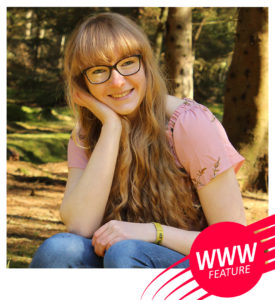WWW FEATURE: Jess Hider
Womenize! Wednesday Weekly is our weekly series featuring inspirational women from games and tech. For this edition we talked to Jess Hider, Technical Designer at Rare. Read more about Jess in this interview:

Hi Jess! You are a Technical Designer at Rare, where you currently work on Everwild. Can you tell us a bit about your role in the team, what is it that a Technical Designer does?
As a technical designer, I come up with features and mechanics that support the vision for our game, but instead of exploring them purely on paper, I’m happy to jump into the game engine myself and start prototyping them out.
For me, this is an incredibly powerful tool to have as a designer. The sooner you can get the concepts out of your head and into someone else’s hands, the better. You learn so much more when you are playing what you are thinking. It also means you can show others what you are thinking, getting them to experience for themselves where your head’s at, which can make it far easier to explain new concepts. You avoid the whole, ‘It’s kind of like this and this, but without that bit and with this extra-ish bit on top’ and can simply be, ‘This is what I mean’.
Your resume shows you’ve already been involved in very different areas of the games industry such as art, animation and community management. What is it that led you to become a Technical Designer at Rare?
Ah yes, my journey definitely jumps about a bit! But now looking back on it, I’d say it was all of my experiences leading me towards Technical Design – I just didn’t know what Technical Design was.
I’ve always been interested in telling stories. I think at the age of twelve, after a stop-motion animation project at high school, I decided I wanted to be an 2D animator for Disney. Fast forward a few years and I’m at Abertay University studying hand-drawn animation amongst other things, and it’s all going well until Disney announced they were closing down their hand-drawn department, and a couple of years later, Studio Ghibli did the same. By that time though, I was being pulled into the world of games rather than films, because it had an intriguing challenge to me – how do you tell stories when a player could go anywhere and do anything?
And that’s something I’m still exploring. One of our core pillars at Rare is ‘Players Telling Stories Together’. How do we enable players to tell their own stories? How do we build spaces where players can be true to themselves and play the way they want to? Finding ways to answer these questions has me skipping into work each day. (Sometimes literally, there are witnesses!)
As I transitioned more into games at uni, I started diving into all sorts of areas – art, animation, vfx, scripting – so by the end of my degree I could build out my own little games in Unreal, taking something from concept through to playing it on my phone. Kudos to Abertay for making the course flexible enough to support this scope of learning, and then to 4J Studios for giving me a taste of how it all applies in a studio environment, because having that broad knowledge of the games pipeline is so useful in my work today.
Being able to work with other disciplines is crucial as a designer. You may have a vision of where you want to go, but if you can’t bring others with you on that journey towards it, then the vision is basically useless. A good start for being able to work with others effectively is understanding their position and their needs, so if you’re able to literally put yourselves in their shoes and try your hand at their processes and pipelines, you start understanding where their requests or frustrations are coming from.
Another part in being able to successfully share your vision is good communication skills. You need to be able to put your ideas across in a way that’s digestible to others, and as I’ve learnt, that often means changing up your communication style to suit your audience – everyone is unique and prefers information in a different format.
For that, I’m grateful for the time I spent as a Community Manager at Epic. I was working with such an array of people (colleagues, devs, corporations, media) and in so many formats (presentations, social, conferences, emails, blogs) I had to step up how I communicated with others. I’m very grateful to Dayna Cowley and Mike Gamble for being wonderful mentors and pushing me forward in this area, because I use these soft skills every single day as a designer.
Without these communication and networking skills, I wouldn’t have ended up at Rare. My Rare journey actually began five or so years ago, when I met the illustrious Louise O’Connor at a Ukie Student Event at EGX. She was sharing her journey of being an animator in the industry and, being a nervous student, I finally worked up the courage to go and talk to her. Over the next few years we reconnected at many different industry events and ultimately it was these encounters, plus some prodding from other Rarians, that led to me joining her team.
Even though my career looks a bit all over the place, everything I’ve done has helped me get to where I am, and the skills I’ve learnt along the way are all things I use in my role now. If you’re reading this, and aren’t quite where you want to be or aren’t even sure where that is, I want to say; whatever you are doing now, don’t discount it. Everything you are doing will help you get to where you want to be – but the path may only be clear when you look back on it.
What would you recommend as a starting point for artists who want to dive deeper into the more technical areas of art, but are afraid to do so?
I’d recommend taking a look at shaders or materials – they’re a very visual representation of maths as art. I enjoyed maths at school, but when it came to things like vectors, I could calculate them but I never truly understood them. But what I loved about materials (especially in Unreal) was I had a way to visualise vectors, and other types of maths, and suddenly things started to make a lot more sense.
There’s loads of great tutorials online to get you started; if you’re using Unreal you have their Introduction to Materials Playlist, I find Klemen Lozar’s twitter particularly inspirational, and I also have a tutorial website with some simple tutorials to get you started.
Thank you for your time Jess!
Jess’s Links:
Jess’s Twitter: https://twitter.com/JessHider
Jess’s Website: https://jesshiderportfolio.wordpress.com/
Jess’s UE4 Tutorials: https://jesshiderue4.wordpress.com/
WWW Feature by Anne Zarnecke

